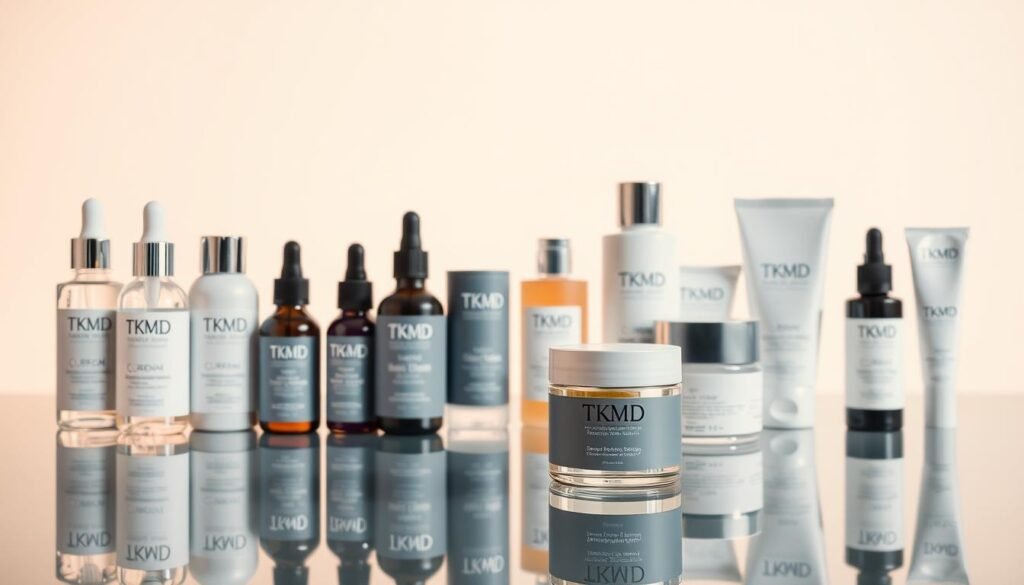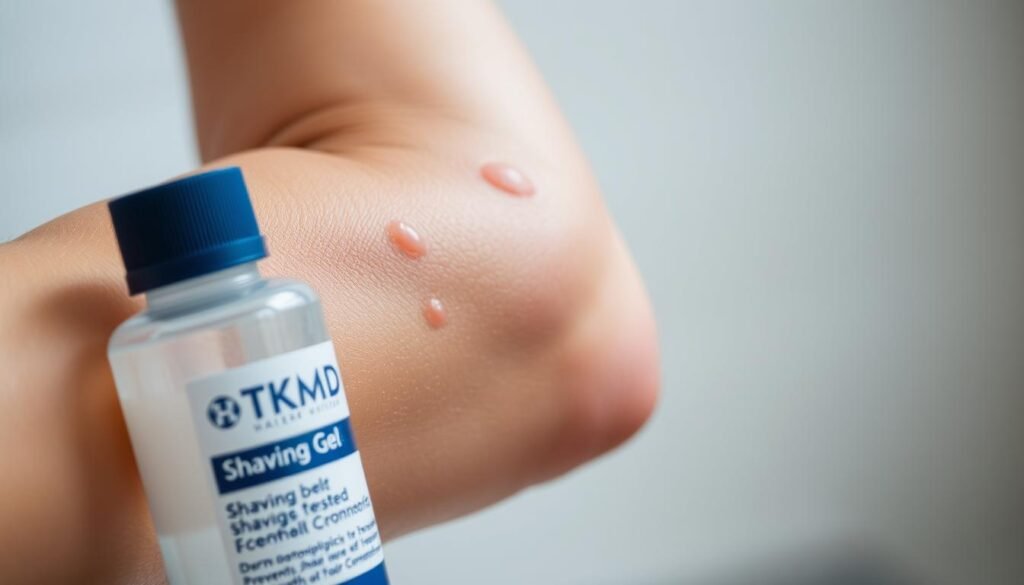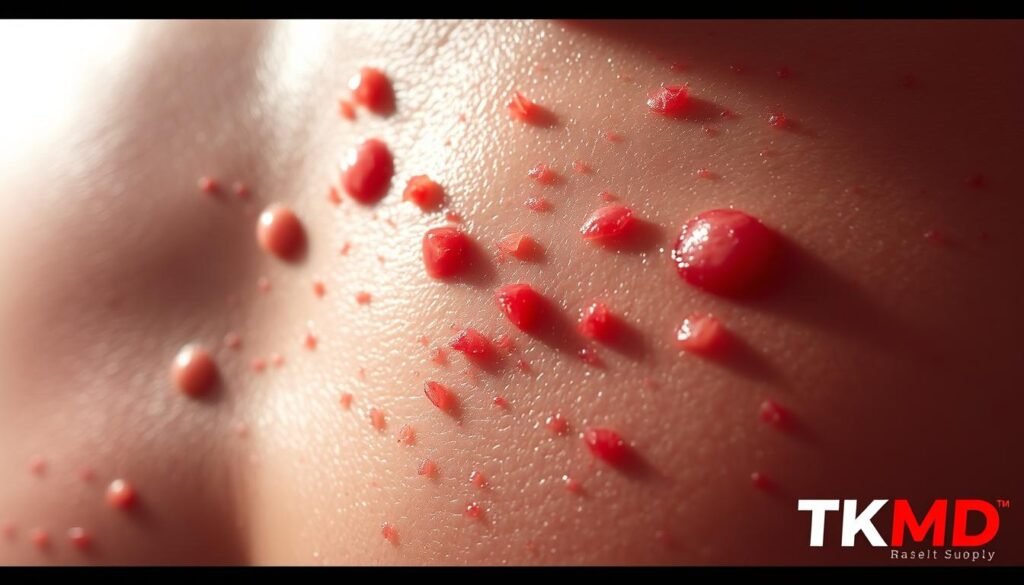Razor bumps, also known as pseudofolliculitis barbae (PFB), can be a persistent problem for many individuals who shave regularly. These bumps occur when hair grows back into the skin instead of outward, leading to inflammation and irritation.
The condition can affect various parts of the body, including the face, legs, and pubic area, causing discomfort and aesthetic concerns. Understanding the causes of razor bumps is crucial for finding effective solutions.
This guide will explore the best methods for treating and preventing razor bumps, ensuring smoother, bump-free skin after hair removal.
Key Takeaways
- Understand the causes of razor bumps and ingrown hairs
- Learn effective methods for treating existing razor bumps
- Discover strategies for preventing new razor bumps from forming
- Explore various treatment options, including over-the-counter products and natural remedies
- Find out how to achieve smoother skin after hair removal
Understanding Razor Bumps: Causes and Risk Factors
Razor bumps are a prevalent issue that affects a wide range of individuals, particularly those with certain hair types. These bumps occur as a result of ingrown hairs, which can cause discomfort, inflammation, and sometimes infection.
What Are Razor Bumps?
Razor bumps, also known as pseudofolliculitis barbae, are small, irritated bumps that appear on the skin after shaving. They are a result of the hair growing back into the skin instead of outward, leading to inflammation and sometimes infection.
Common Causes of Razor Bumps
The primary cause of razor bumps is the way hair grows back after shaving. When hair is cut close to the skin, it can sometimes curl back into the skin instead of growing out, causing irritation. Other factors include shaving too closely, using a dull razor, and shaving over the same area multiple times.
Who Is Most at Risk?
Certain individuals are more prone to developing razor bumps, including people with curly or coarse hair. Males of African descent and people with dark skin tones are at a higher risk. Additionally, people who shave frequently, especially in sensitive areas like the face, legs, or groin, are more likely to experience razor bumps.
How to Get Rid of Shaving Bumps: Immediate Solutions
Razor bumps are a common issue for many, but fortunately, there are several immediate treatments that can provide relief. When dealing with razor bumps, it’s essential to address the issue promptly to prevent further irritation and potential infection.
Stop Shaving Temporarily
One of the most effective immediate solutions is to stop shaving temporarily. Avoiding shaving for a few days allows the skin to heal and reduces the risk of further irritation. This simple step can significantly alleviate the discomfort associated with razor bumps.
Applying Cold Compresses
Applying a cold compress to the affected area can help reduce inflammation and ease the discomfort. The cold temperature constricts the blood vessels, which can help minimize redness and swelling. Cold compresses are a quick and easy remedy that can be done at home.
Using Over-the-Counter Products
Several over-the-counter (OTC) products are available that can help treat razor bumps. These products often contain ingredients like salicylic acid or glycolic acid, which help exfoliate the skin and unclog pores. Using OTC products can be an effective way to manage razor bumps without needing a prescription.
Gentle Exfoliation Techniques
Gentle exfoliation is crucial for removing dead skin cells that can trap hairs beneath the skin’s surface, causing razor bumps. Using a soft-bristled brush or washcloth to lightly exfoliate the affected area can help release trapped hairs and promote proper growth direction. A table summarizing gentle exfoliation techniques is provided below:
| Exfoliation Method | Description | Benefits |
|---|---|---|
| Soft-bristled brush | Gently brush the affected area in circular motions | Removes dead skin cells, promotes hair growth in the right direction |
| Washcloth | Use a washcloth to gently exfoliate the skin | Helps remove debris, reduces ingrown hairs |
| Chemical exfoliants | Use products containing alpha hydroxy acids (AHAs) or beta hydroxy acids (BHAs) | Provides a gentler alternative for sensitive skin, helps unclog pores |
By incorporating these immediate solutions into your skincare routine, you can effectively manage and reduce the appearance of razor bumps. Remember to always follow the product instructions and consult a dermatologist if the issue persists.
Natural Remedies for Treating Razor Bumps
Nature offers a variety of remedies that can help alleviate the discomfort and appearance of razor bumps. These natural solutions can be particularly appealing to those looking for alternatives to commercial products or chemical treatments.
Aloe Vera Applications
Aloe vera is known for its soothing properties and can be applied directly to the affected area to calm irritated skin. Its anti-inflammatory properties can help reduce redness and swelling associated with razor bumps.
Tea Tree Oil Treatments
Tea tree oil has antimicrobial properties that can help prevent infection in razor bumps. When diluted with a carrier oil, it can be applied to the affected area to promote healing and reduce inflammation.

Warm Washcloth Method
Applying a warm washcloth to the affected area can help open up the pores and reduce inflammation. This simple technique can be an effective addition to your home remedies routine for treating razor bumps.
Other Effective Home Remedies
Several other natural remedies can be effective in treating razor bumps. For instance, gently exfoliating the affected area with a mixture of sugar and olive oil can help remove dead skin cells. Additionally, using witch hazel as an astringent, applying aspirin paste to reduce inflammation, or utilizing coconut oil for its antimicrobial benefits can be beneficial. Other options include apple cider vinegar as a toner, honey masks for their antibacterial properties, and oatmeal baths for soothing widespread irritation.
Chemical Treatments and Products
Chemical treatments offer a potent solution for those struggling with razor bumps. These treatments typically involve products containing exfoliating acids that help to remove dead skin cells and prevent ingrown hairs.
Salicylic Acid Products
Salicylic acid is a beta-hydroxy acid that is commonly used to treat skin irritation caused by razor bumps. Products containing salicylic acid, such as cleansers and creams, help to unclog pores and reduce inflammation. For sensitive skin, look for fragrance-free, alcohol-free products with lower concentrations of active ingredients.
Glycolic Acid Solutions
Glycolic acid is an alpha-hydroxy acid that helps to exfoliate the skin, promoting cell turnover and reducing the appearance of razor bumps. It is available in various formulations, including gels and creams. When using glycolic acid products, it’s essential to follow the instructions carefully to avoid over-exfoliation.
Choosing the Right Products for Your Skin Type
When selecting chemical treatments, it’s crucial to choose products that suit your skin type. For example, oily skin benefits from gel-based or lightweight lotion formulations, while dry skin requires cream-based products with hydrating ingredients. Always perform a patch test with new products to check for adverse reactions.

Prevention Techniques for Smooth Shaving
Razor bumps and ingrown hairs can be a nuisance, but understanding prevention methods can make a significant difference. By adopting the right shaving techniques and aftercare, you can significantly reduce the occurrence of razor bumps.
Proper Pre-Shave Preparation
Preparing your skin before shaving is crucial. Exfoliate gently to remove dead skin cells, and use a warm washcloth to soften the hair. This helps the razor glide more smoothly, reducing irritation.
Correct Shaving Techniques
Shaving in the direction of hair growth, rather than against it, is essential to prevent ingrown hairs and razor bumps. Use a sharp razor and shave with light strokes, avoiding applying too much pressure.
Post-Shave Care
After shaving, rinse with cold water to close the pores, and apply a soothing aftershave balm or lotion to calm the skin. Regularly moisturizing the areas you shave can also help to keep the skin healthy and reduce irritation.
Alternative Hair Removal Methods
For some, alternative methods may be more effective in preventing razor bumps. Options include depilatory creams, waxing, and laser hair removal. While these methods have their pros and cons, they can help prevent ingrown hairs and razor bumps.
- Electric trimmers can reduce razor bumps while maintaining a groomed appearance.
- Depilatory creams dissolve hair at the surface, reducing ingrown hairs but may cause irritation.
- Laser hair removal targets the hair follicle, reducing hair growth over time.

When to Seek Medical Treatment
When razor bumps become severe or infected, it’s crucial to seek medical treatment to prevent further complications. While many cases can be managed with home remedies, some instances require professional intervention to avoid long-term damage to the skin.
Signs of Infection
If you notice signs of infection such as increased redness, swelling, or pus around the razor bumps, it’s essential to consult a dermatologist. Infected hair follicles can lead to more severe conditions if left untreated.
Prescription Treatment Options
Dermatologists can offer various prescription treatments for persistent or severe razor bumps. These may include topical or oral medications to reduce inflammation and prevent infection. In some cases, steroid injections may be used to rapidly reduce swelling.
Professional Procedures for Severe Cases
For severe or recurrent cases, several professional procedures are available. These include laser hair removal, which targets the hair follicle to reduce future growth, and chemical peels that help remove the outer layer of skin and release trapped hairs. Other options like electrolysis and extraction procedures can provide long-term solutions for areas chronically affected by razor bumps, particularly on the face or other sensitive areas. In extreme cases, treatments for pseudofolliculitis barbae may be necessary.
Conclusion
Achieving smooth skin without the nuisance of razor bumps requires a strategic approach. The most effective way to get rid of razor bumps is to stop shaving, allowing the hair to grow and preventing new bumps from forming. However, this may not be a feasible solution for everyone.
Various treatments can help manage razor bumps, including natural remedies like aloe vera and tea tree oil, which offer gentle yet effective options. Chemical exfoliants containing salicylic acid or glycolic acid provide more powerful treatment options by removing dead skin cells and freeing trapped hairs.
Prevention remains the best strategy, with proper pre-shave preparation, correct shaving techniques, and diligent post-shave care forming the foundation of razor bump prevention. For those with persistent or severe razor bumps, professional medical treatments ranging from prescription medications to laser hair removal can provide more permanent solutions.
By understanding your skin type, hair texture, and personal risk factors, you can develop a customized approach to achieve smooth, bump-free skin after hair removal. Consistency is key—maintaining a regular skincare routine and proper shaving habits will yield the best long-term results in preventing and treating razor bumps.


